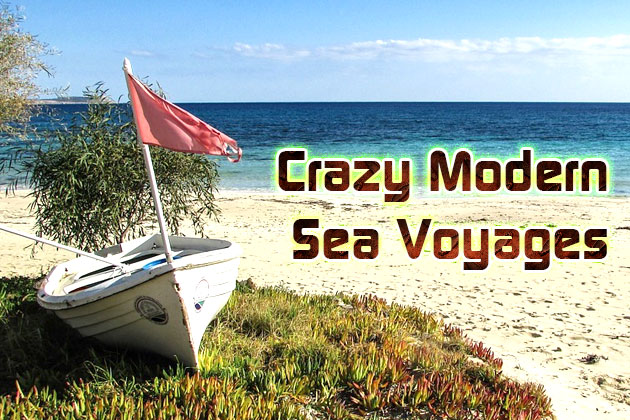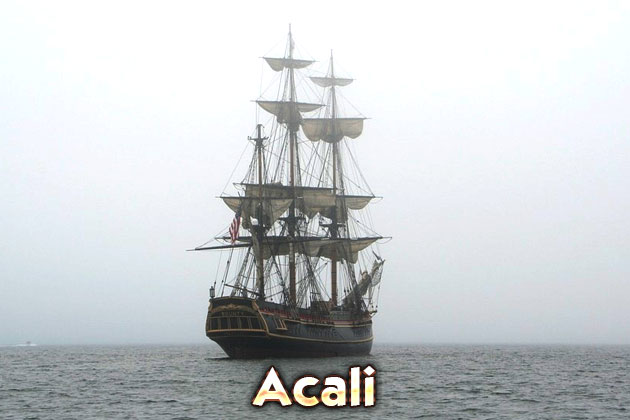There are a lot of people who are brave enough to embark on a sea voyage alone, often in their own amateurishly-constructed vessels. Check out the crazy modern sea voyages here in this article!
Kon-Tiki
Norwegian seafarer Thor Heyerdahl was known for his Kon-Tiki and Ra II Sea voyages. In 1947 he set out his famous odyssey (or “ody-sea,” if you may) to test his theory on the Peruvian migration to the South Pacific islands during the ancient times (before Christopher Columbus’ expedition). With his hand-built raft Kon-Tiki, he crossed 8,000 miles across the Pacific Ocean from South America from the Polynesian islands.
Tahiti-Nui and 2nd Tahiti Nui
Eric de Bisschop was a French seafarer who built a Polynesian raft out of Tahitian bamboo and embarked on a seafaring journey, in 1956. The raft, called the Tahiti-Nui, crossed the eastern Pacific Ocean from Tahiti to Chile. He made this journey to disprove Thor Heyerdahl’s Kon-Tiki expedition which was designed to demonstrate his own theory that South Americans crossed the South Pacific and got in touch with the Polynesians and their culture.
When de Bisschop and his crew of five reached halfway to South America in May 1957, the raft was disintegrating. After 199 days of being at sea, the raft sank and de Bisschop radioed for rescue. He survived.
Undeterred by the failure, he built another Polynesian raft (also named Tahiti-Nui) to attempt another seafaring voyage in 1958. But tragically, the boat was swept along while approaching the Cook Islands and went aground at the shore. Only de Bisschop died in this accident, but the rest of his crew survived.
Acali
Santiago Genoves was a Mexican anthropologist who worked with Thor Heyerdahl on his Ra expedition, during which he conceived an altogether different “laboratory of human behavior” — that “laboratory” turned out to be a raft, which was to be called Acali. He and his motley crew of 11 people coming from different cultural backgrounds sailed on the raft. The Acali surprisingly survived after the 101-day journey from the Canary Islands to Mexico, despite all adverse challenges.
Excalibur
In 1981 Curtis Saville and his wife Kathleen used their 25-foot boat named the Excalibur to row across the Atlantic Ocean from Casablanca, Morocco to Antigua. They made it out successfully after 83 days at sea.
The Cork Boat
John Pollack built what could be the unlikeliest boat ever — a 22-foot Viking ship made almost entirely of thousands of corks. Of course, he used this boat to row down the Douro River in Portugal, and the fluvial expedition became successful. He and his cork boat gained significant media attention and were the subject of a 2004 book Cork Boat.
Starkell’s Canoe
The late Canadian adventurer and author Don Starkell is known for his incredible feats in canoeing. Well, not as a competitive sport but as a personal adventure. In 1980, he and two sons set out on an epic paddling expedition from Winnipeg, Manitoba to Belem, Brazil. Over 12,000 miles after, along with capsizes, venomous snakes and rebels and drug lords, the Starkells arrived at the mouth of the Amazon River.
Ra II
Thor Heyerdahl’s first boat Ra was built mostly on papyrus, in the manner of the ancient Egyptian ships which were widely assumed to be capable only of fluvial sailing. Heyerdahl, however, sailed it on the rough seas as part of his attempted voyage from Africa to the Americas; the fragile boat eventually disintegrated mid-sea.
However, Heyerdahl and his crew were undaunted by the initial failure. They built another boat Ra II in 1970; a year after the first Ra was built and sailed. Like the first boat, the Ra II was also built with papyrus reeds. In 57 days, Ra II successfully sailed over 4,000 miles from Morocco to Barbados.
Seven Little Sisters
In 1954 American sailor William Willis set out on his first solo sea voyage from South America to American Samoa by “piloting” a balsa wood raft called Seven Little Sisters. He sailed an incredible 6,700 miles across the Pacific Ocean; he and his pet cat survived all the storms, the sharks and the lack (and contamination) of his food supply. Willis was 61 years old when he made this amazing sea voyage.
Phoenician
British fund manager turned adventurer Philip Beale set out for the Phoenician Ship Expedition in 2008. This was to duplicate the first Phoenician sailors’ first route during 600 BC, to prove that ancient Phoenician ships could travel through African seas. Beale sailed on the replica of the ancient Phoenician ship, which 20 meters (about 65 feet) meters long. The expedition ended in 2010 when the ship arrived in South Africa.
Lehi IV
Devere Baker was a Mormon who wanted to prove a theory that Israelies sailed from the Red Sea to Central America where they began their colonization, just after reading the Book of Mormon. He began to build a raft called Lehi IV — notice the “IV” in the name as his first three rafts were failures.
But the Lehi IV actually floated and Baker began to set out his sea journey from Redondo Beach on July 5, 1958. After being at sea for 69 days, he safely arrived in Maui, Hawaii. What does it have to do with the Red Sea to Central America? Despite the pointlessness of the journey, it became otherwise successful.
Conclusion
Sea voyages hide in them courageous heroes and stories of passion, struggle and victory. The best and the most challenging thing about sea voyages is its unpredictable nature, as no sailor can completely predict nature, but it is the love for the sea that keeps every sailor hooked to this crazy field.




